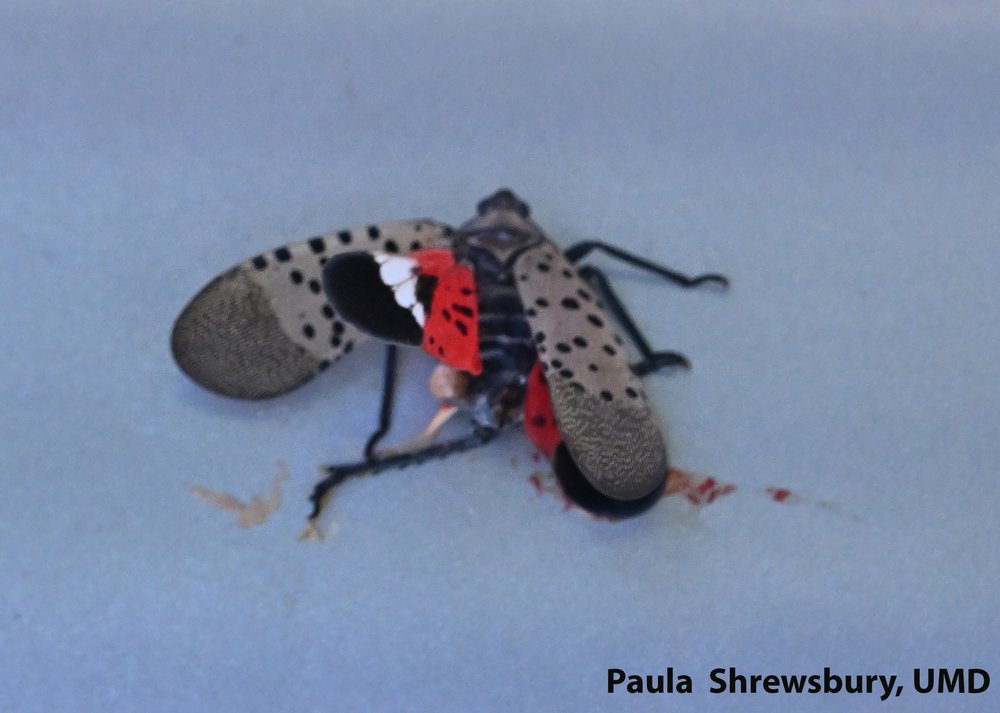Fright and fun courtesy of flying spotted lanternflies, Lycorma delicatula

Encounters with humans often result in lanternflies feeling a little flat. Image: Paula Shrewsbury, UMD
Last week Bug of the Week received a text regarding swarms of spotted lanternflies visiting children and adults at a public park in Carroll County, Maryland. Sure enough, a trip to the park revealed squealing kids, nervous parents, and scores of spotted lanternfly adults flitting about and landing on slides, swings, play sets, and people. While some children screeched and ran, others delighted in the heavily promoted and much-heralded sport of chasing down lanternflies and squashing them. What fun! Ah, but not all children embraced an ant-bully mien. While recording a lanternfly climbing up my leg, a youngster nearby asked if he could have one on his leg, too. Nice to meet a budding entomologist!
As one youngster said, “there’s a thousand of them….” Lanternflies take flight in late summer and autumn. When lanternflies invaded a playground in Maryland some children shrieked and ran while others laughed and tried to catch some. What strange attraction brought lanternflies to playsets, slides, and people remains a mystery. A memorable time was had by all, fearful and fun-loving alike, except perhaps, the lanternflies flattened by sneakers, flipflops, and baseball caps.

Why spotted lanternflies invaded this playground in Maryland remains a mystery. Image: Paula Shrewsbury, UMD
What causes spotted lanternflies to abandon a site and engage in flight, swarming to new locations? Fascinating studies by scientists in Pennsylvania reveal some of the secrets to the autumnal movements of adult spotted lanternflies. Thomas Baker and his colleagues at Penn State discovered that the long-distance airborne lanternflies were primarily slim unmated females. These fliers were capable of flights ranging from roughly 30 to 150 feet. Their spontaneous flights were believed to be quests to find suitable hosts, plants that could supply sufficient nutrients for them to fatten up and deposit a complete complement of eggs before cold weather put an end to their mischief. The Penn State team also assessed the flight worthiness of plump yellow-bellied lanternflies. These females were full of developing eggs. A vast majority of these heavy females had successfully mated but their ability to fly was weak and limited to only about 12 feet when launched into the air. According to lanternfly expert, Dr. Kelly Hoover, spotted lanternflies may undertake long-distance flights when their sustained feeding has depleted resources in trees and they fly to find better quality food resources in trees elsewhere.
On a sunny late summer afternoon in a restaurant park in scenic Rohrerstown, PA, spotted lanternflies were on the wing. They crashed into windows, wandered on sidewalks, and met gruesome ends beneath human feet and tires of vehicles. Wanderers displayed their impressive jumping skills when harassed by a giant finger and one contemplated a trip to New Jersey on the rear bumper of my car.

Since its discovery in Berks County, Pennsylvania in 2014, spotted lanternfly has established populations in locations more than 600 miles away. New York State Integrated Pest Management Program of Cornell University.
While autumnal spontaneous flights have been witnessed on a regular basis, these relatively short distance flights of hundreds of feet likely account for only a minor component of the spotted lanternflies’ spread through the United States. From their initial discovery point in Berks County, PA in 2014, isolated spotted lanternflies infestations have popped up in midwestern and southern states more than 600 miles away. The most likely explanation for these long-distance peregrinations lies in human-assisted transport of lanternfly eggs. Unlike many herbivorous insects that lay eggs on food plants for their young, spotted lanternfly mothers deposit egg masses on non-host objects including stones, cinder blocks, lawn furniture and vehicles, in addition to trees. These nondescript masses of eggs are easily overlooked on natural and human-made items and easily transported inadvertently by road or rail. Recently, a metal sculpture festooned with spotted lanternfly eggs being shipped from New York to Sonoma, California was intercepted at the border before entering our leading wine producing state. Great work by the California Department of Food and Agriculture at the Truckee Border Station.
Why this particular playground attracted hordes of flying lanternflies remains a mystery. A similar play area less than 300 yards way was devoid of these critters and also devoid of children. Maybe lanternflies just saw the kids having a good time and wanted to join in the fun. Who knows?
Acknowledgements
Special thanks to Brian and Jackie for providing the inspiration for this episode and to the children playing at the park who shared their excitement and trepidation. Thanks to Dr. Paula Shrewsbury for providing images of lanternflies. The fascinating articles “Flight Dispersal Capabilities of Female Spotted Lanternflies (Lycorma delicatula) Related to Size and Mating Status” by Michael S. Wolfin, Muhammad Binyameen, Yanchen Wang, Julie M. Urban, Dana C. Roberts, and Thomas C. Baker, and “Spotted lanternfly collective flights in late summer not dangerous to public” by Amy Duke were used to prepare this story. Thanks to Brian Eshenaur and the entire team at the New York State Integrated Pest Management Program of Cornell University for providing the updated maps of spotted lanternfly in the US and to the Entomological Society of America for providing the map of the potential distribution of spotted lanternfly in the US.
This post appeared first on Bug of the Week